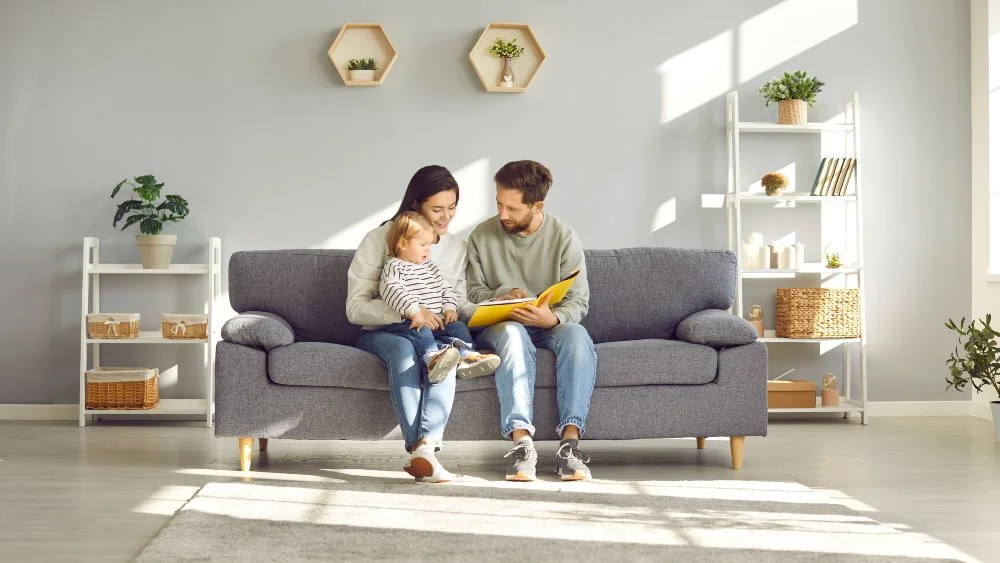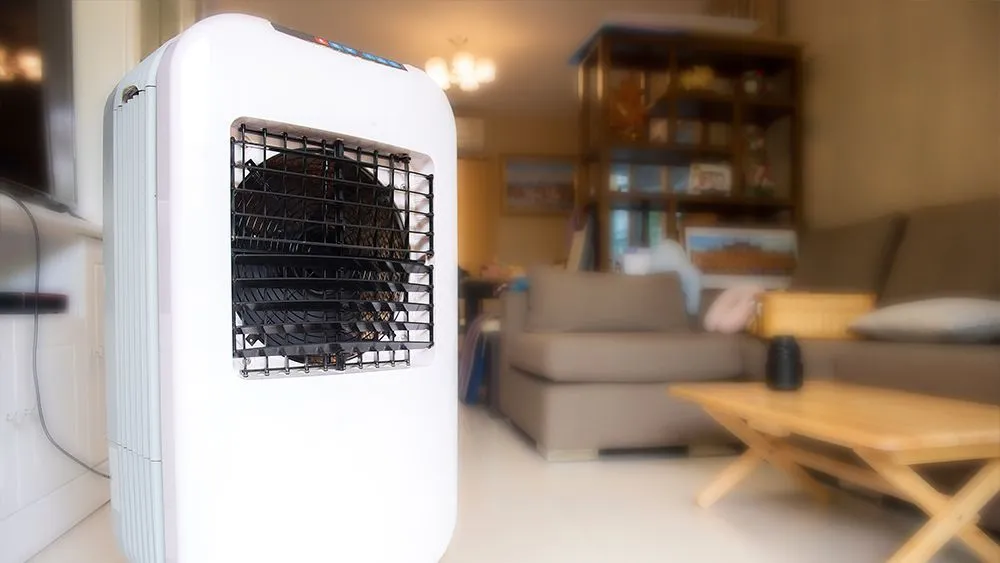
Key Takeaways
- Evaporative coolers use water for cooling, while air conditioners rely on chemical refrigerants to remove heat and humidity.
- ACs can work in any climate, while swamp coolers are only designed for dry areas.
- Choose swamp coolers for affordability and ACs for comfort and consistent cooling.
Staying cool during the hot summer months is crucial for comfort and health, but selecting the right cooling solution can be tricky. You might get confused when deciding between two popular options—evaporative cooler vs. air conditioner. Each system operates on different principles and offers unique advantages depending on your requirements and climate conditions.
This evaporative cooler vs. air conditioner blog will explain the specifics of these systems and compare their performance, energy efficiency, and cost-effectiveness to help you decide which cooling system is best for your home.
What Are Evaporative Coolers?

Evaporative cooling systems, often known as swamp coolers, are a cost-effective alternative to traditional air conditioning. They add moisture while lowering your home temperature, making them ideal for dry climates.
| Pros | Cons |
|
|
|
|
|
|
|
What Are Air Conditioners?

Air conditioners cool indoor spaces by removing heat and humidity from the air. They provide consistent comfort even in extremely hot conditions. However, they consume more energy, which may result in higher electricity bills.
| Pros | Cons |
|
|
|
|
|
|
|
Differences Between an Evaporative Cooler vs. Air Conditioner
When it comes to swamp coolers vs. air conditioners, consider the following distinctions:

-
Evaporative Coolers Use Water for Cooling, While ACs Use a Chemical Refrigerant
Evaporative coolers work by drawing warm air from the outside via water-soaked pads. The water evaporates from these pads, cooling the air by 15F to 40F, which is then circulated to the room by a fan. This can reduce indoor temperature, especially in hot, dry conditions. However, the effectiveness of evaporative coolers decreases in locations with high humidity, making them best suited for regions like the Western and Southwestern United States.
Two-stage evaporative coolers are also a more advanced option than single-stage models. They incorporate pre-cooler pads, which help them cool air more effectively while adding less humidity to your home.
Any type of air conditioner, whether a central, portable, or window unit, operates on the basis of the refrigeration cycle. A chemical called refrigerant absorbs heat and moisture from your home and turns it into a gas. The hot gas is sent through coils outside, where it releases its heat and turns back into a liquid. At the same time, the cool, dry air is circulated inside your home.
-
Evaporative Coolers Bring in Fresh Air, While ACs Are Better for Allergy Sufferers
Air conditioners are more equipped to improve indoor air quality. They use air filters to purify the air and ensure that no air pollutants enter your home. However, they do not bring fresh air from outside and just recirculate the existing air.
Evaporative coolers are designed as open systems, which means they require some doors or windows to be at least partially open while in use. This setup helps bring fresh air inside.
However, for individuals with allergies, this fresh air intake might not always be beneficial. People sensitive to pollen or other allergens might find that an AC suits them as it operates with the windows closed and filters out the allergens. Additionally, in areas where air pollution or wildfire smoke is a concern, evaporative coolers could draw in harmful pollutants like smoke.
Related: What Is an Air Conditioner Allergy and How to Prevent It? –A Brief Guide!
-
Swamp Coolers Are Less Expensive Than AC Units
When it comes to creating a comfortable living space, budget plays a crucial role. Swamp coolers are generally more affordable, with prices costing between $40 to $2,300, depending on the size and type of unit. You can install the portable evaporative cooler yourself, but you will need a professional to install the whole-house coolers. On average, an HVAC professional charges between $50 and $70 an hour.
The AC can cost between $100 and $12,000, with portable AC units on the more affordable end and geothermal HVAC systems on the expensive side. The average cost of AC installation is between $3,800 to $7,500.
Another significant difference is in operating costs. Evaporative coolers are much more energy-efficient, using up to 80 percent less electricity than air conditioners. However, they usually have a shorter lifespan. Most swamp coolers come with a 5-year warranty and have a lower lifespan than air conditioners, which can last up to 20 years.
-
Air Conditioners Work Well in Any Kind of Climate, Evaporative Coolers Perform Only in Dry Areas
A key difference in the evaporative cooler vs. air conditioner debate is the type of climate they are best suited for.
Air conditioners provide consistent cooling regardless of the weather conditions. However, in extremely dry conditions, it might make you feel uncomfortable as an AC also dehumidifies as it cools. This can cause dry skin and potentially damage wooden floors and other wooden items in the home. In this case, running a humidifier can help.
Swamp coolers work best in arid conditions as they tend to add moisture to the air. In dry climates, like those found in the Southwest, this added humidity can be beneficial. However, if you live in humid areas, installing a swamp cooler can encourage the growth of mold, mildew, and other pathogens that flourish in damp conditions. Evaporative units are also less effective during or right after rainstorms because the rain increases humidity in the air. During the monsoon season, you can use a swamp cooler in fan-only mode. Although this won’t cool the air, it will help with ventilation in your home.
Related: Ideal Indoor Humidity Summer Guide
-
Evaporative Coolers Are More Environmental Friendly Than Air Conditioners
While modern air conditioners use safer refrigerants, they still pose health and environmental risks if leaks occur. Plus, ACs require more electricity to operate than swamp coolers, which results in higher CO2 emissions. Air conditioners account for around 6% of the total electricity consumption in the US, leading to the emission of approximately 117 million metric tons of carbon dioxide annually.
In contrast, swamp coolers use the natural process of evaporation to cool the air, resulting in lower electricity consumption, reduced CO2 emissions, and quieter operation.
-
ACs Require Less Frequent Maintenance Compared to Swamp Coolers

Swamp coolers, while eco-friendly and cost-effective, require regular upkeep. This is because as the water flows through the unit, it can leave behind minerals and sediment that might affect its performance if not cleaned on time. You should clean it at least once per cooling season, and this frequency can increase depending on the usage and the weather.
The water tank should be sanitized twice a week, and the cooler pads should be replaced twice a season or monthly if the unit is used frequently. Additionally, check the pump, filter, and reservoir every time you clean the cooler.
In contrast, air conditioners require far less maintenance. A yearly checkup by a professional is generally sufficient. In addition, you should take care of simple HVAC maintenance tasks like cleaning the filters and keeping the outdoor unit clear of debris.
-
Portable Evaporative Coolers Can Be Used Outdoors, While ACs Are for Indoor Use Only
Air conditioners are designed to cool the inside of your home, while evaporative coolers can be used both indoors and outdoors.
The swamp cooler won’t significantly alter the overall outdoor temperature; however, it can lower the air temperature by up to 10 degrees, offering a refreshing break on a hot summer day.
Choosing Between a Swamp Cooler vs. Air Conditioner
The choice between an evaporative air cooler vs. air conditioner is determined by your personal preference, local climate conditions, and your cooling needs. While swamp coolers can be an energy-efficient cooling option under the right conditions, they may not be suitable for everyone. They are most effective in dry, arid regions and perform poorly in areas with high humidity. Additionally, they require windows to be left open, allowing warm air, dust, and pollutants to enter. Air conditioners, on the other hand, can work well in different climates. They provide superior cooling performance and help maintain your ideal home temperature. Plus, they filter out any pollutants, improving air quality in your home.








